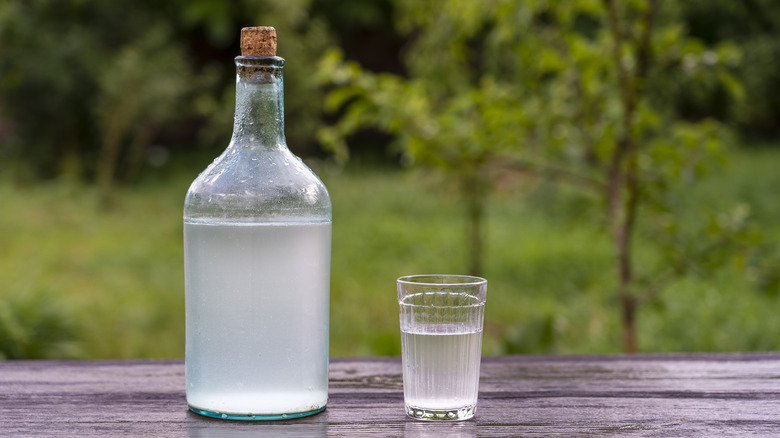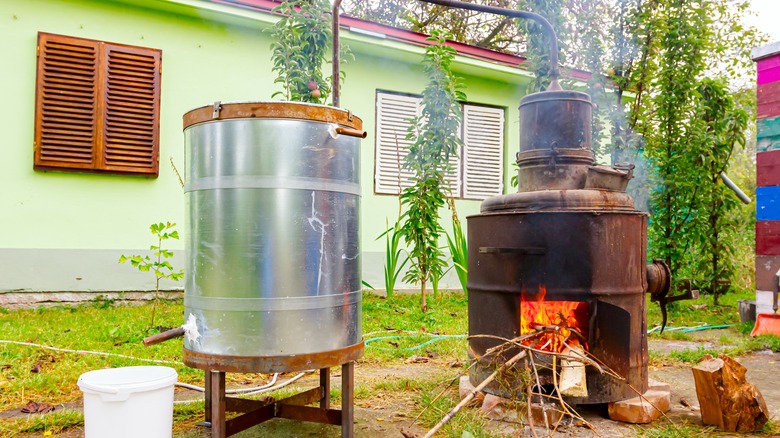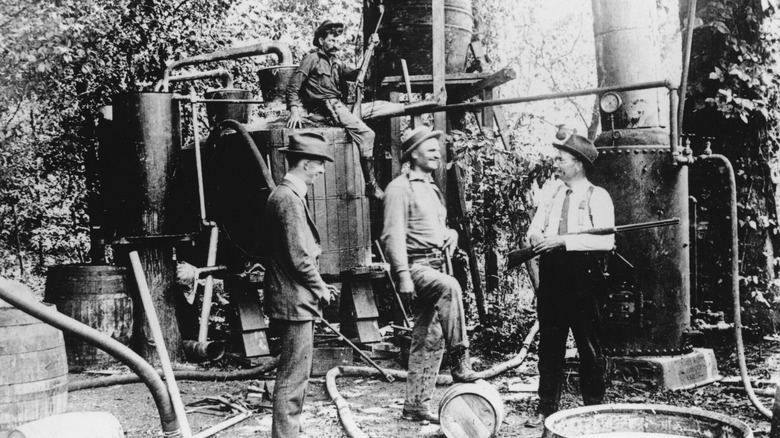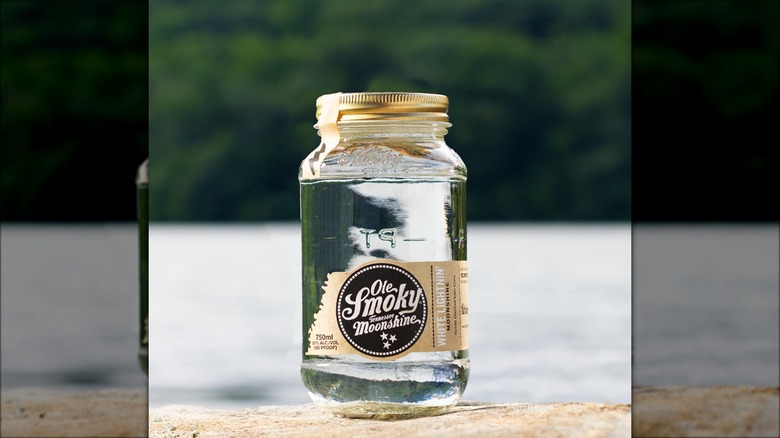What Totally Legal, Liquor Store 'Moonshine' Is Really Made Of
In the collective mind, moonshine is another word for bathtub gin or alcohol made on the run from the feds in the backwoods. It appeals to the American entrepreneurial spirit and, for a long time, was illegal to produce. It wasn't until 2010, when the economic crisis hit Appalachia, that moonshine production was legalized and allowed once illegal distillers to become legitimized.
Moonshine, as it's sold now, is a marketing ploy that appeals to the allure of a speakeasy during Prohibition — something illicit, secret. While the U.S. government does regulate what can be called bourbon or whiskey, it doesn't regulate the use of "moonshine." So what you're getting at the liquor store is either a neutral grain spirit similar to vodka or a clear, unaged whiskey. The difference between those two is that neutral spirits must leave the still at 95% alcohol or higher, while whiskey should be distilled to less than 95%. Take a gander at the label — some brands will call their moonshine white whiskey or unaged whiskey. What you get at the liquor store today is moonshine in name and branding only.
Moonshine is whiskey that hasn't been taxed
Moonshine is what comes to mind when we think of the Roaring '20s, with flappers and speakeasies peddling bathtub gin or bootleggers on moonshine runs evading the fuzz in their Ford Model A Coupes. Authentic moonshine is illegal, full stop. It's generally made at home and flouts many of the necessary government laws and restrictions on distilling spirits. As early as the 1700s, American farmers had a surplus of grains like corn and rye and distilled them into whiskeys and high-proof liquors. When the government came calling for its taxes (to pay down debts from the Revolutionary War), illegal distilleries started popping up. And when Prohibition was passed in 1920, moonshine and bootleggers were more popular than ever.
Moonshine can be made from anything fermentable, be it grain, sugar, or fruit. It's akin to whiskey in its process, but moonshine tastes more like vodka due to its unaged aspect. When it comes to how much alcohol is in moonshine, it's like Lindsay Lohan in "Mean Girls" — the limit does not exist. Some of them even peak at 190 proof. But when it comes down to it, real moonshine is moonshine because it is illegal. Anything on the liquor store shelves and marketed as moonshine is either a high-proof neutral spirit or an unaged whiskey.
The urban legend of moonshine making you blind has a nugget of truth to it
Until 1978, brewing your own beer and wine was illegal, but now you can produce up to 200 gallons of wine and beer a year. You can even own a still; the feds don't have to know about it. It's when you consider distilling spirits that you run into some hurdles.
Anything called moonshine at the liquor store is made in a fully licensed, legally compliant distillery, so you know it's safe to drink. Whatever someone does in their basement is not subject to those quality controls. The process is dangerous, as the pure alcohol is highly flammable. Some moonshiners even add back methanol to boost the ABV, but just 10 milliliters of the stuff can cause some serious damage to your optic nerve.
The reason real moonshine is illegal? Uncle Sam wants his money. In 2020, the government collected more than $235 million from legal spirit sales — the higher the ABV, the higher the tax owed. To put it in perspective, that's over half the revenue from all alcohol sales that year. Any illegal distilleries mean that the U.S. government is missing out on some serious cash — a 750-milliliter bottle of 80-proof vodka owes $2.14 to the government. A 1999 raid in Virginia uncovered materials and equipment capable of producing 1.5 million gallons of "real" moonshine, or $19.6 million in lost taxes. That's a lot of money to be left in the stills.
Legal moonshine is widely available at liquor stores
You can buy legally distilled moonshine at your local liquor store, especially brands with a bit more reach. Artisanal moonshine is starting to make inroads, but you can use apps and websites like Drizly or Reserve Bar to find bottles of high-quality, legal moonshine.
Ole Smoky Blue Flame Moonshine is distilled in Tennessee and packs a punch — it's a whopping 128-proof (64% ABV) and a light blue color, in a nod to the story that moonshine burns a blue flame. The Ole Smoky Distillery opened in 2010 when Tennessee amended its laws and allowed distillers to operate in the state. They also distill Ole Smoky White Lightnin', a 50% ABV neutral grain spirit similar in flavor to vodka or gin. It's a great add-in for a homemade apple pie moonshine cocktail. They've expanded their product line into popular Ole Smoky Moonshine flavors like pumpkin spice, apple pie, and dill pickle.
Sugarlands embraces the moonshine mystique and is the official moonshine of NASCAR. If you're not familiar with the provenance, it's extremely interesting. Their Jim Tom Hedrick's Unaged Rye is 50% ABV and has notes of rye and black pepper. And don't miss out on moonshine that's been given the charcoal treatment like Saint Luna Charcoal Filtered Moonshine. The filtering process makes a pure spirit that's still complex, elegant, and sippable.



